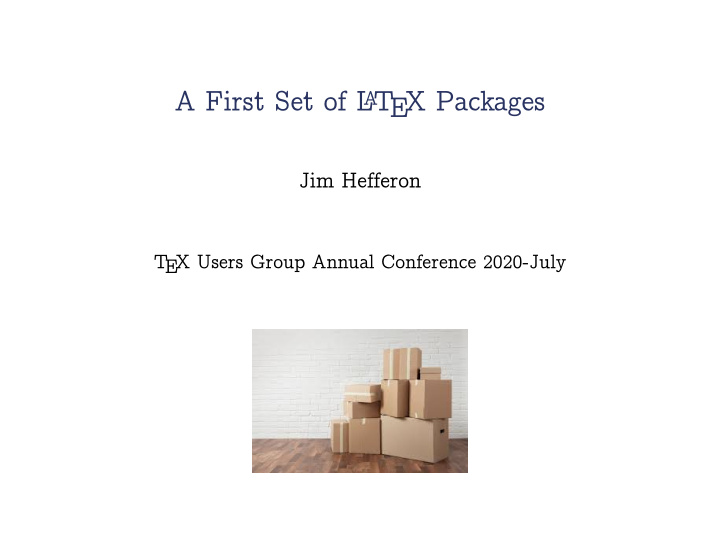



A First Set of L T EX Packages A Jim Hefferon T EX Users Group Annual Conference 2020-July
Abstract This describes a curated list of packages that covers most of what beginners want to do. It seeks to name one package in each area that is capable and reliable.
Overview At TUG 2019 I reported on using social media to help understand the needs of today’s beginners. Often they just need the right package. I am developing a suitable set. I kept the document to two sides of a page, aiming to have only one package per problem. Beyond solving the problem, the criteria for a package to be included is that it is in the distributions and largely bug-free. The end document will be in PDF, HTML, and video. The PDF will be on CTAN. I’m here to solicit feedback.
Document structure The document core consists of a few sections classifying areas. Each package name is a hyperlink, with a terse description. There are also a few extra comments in parentheses that often come up in conjunction with the recommendations, and below I have omitted some of these. Before the list is an introduction. It mentions CTAN. It also mentions using texdoc to read local documentation. Finally, it notes that if a person is writing for a journal or institution then they must see if it has its own package.
Package set
Every document � To change margins, page size, and orientation, use geometry . � Get multiple columns with multicol . � Any document containing significant amounts of mathematics should use the American Mathematical Society’s packages amsmath and amssymb , as well as amsthm for producing theorem environments. Don’t load amsmath directly, instead get it by loading mathtools , which adds some useful improvements. � You can toss in microtype . My eye can’t spot the improvements but I appreciate that it means that there are fewer awkward lines.
Inside the document � To tweak lists, use enumitem . � Enhance captions with caption . Control floating environments with float . (In particular, if you want an option that overrides automatic float placement and puts something exactly where you ask, this package provides the option ‘ H ’.) � Get hyperlinks and turn references into links with hyperref . Make cross-references say ‘Theorem 1.2’ instead of just ‘1.2’ with the one-r-ed cleveref . Have URL’s and file paths that can linebreak with url . � I do code listings with listings (although minted also has a lot going for it). Make single quotes inside verbatim text come out correctly with upquote .
� For code in Python have a look at pythontex , which, besides showing the code listings, also allows you to execute Python and put the results in your output. Do the same for the Sage mathematics software suite with sagetex , and similar systems exist for R, Haskell, and Scheme. � There are many package that add table capabilities such as multirow entries and breaking across pages. I most often use array , which lets you define your own columns. To handle units, use siunitx (which also has a table column type for aligning on a decimal point). � To make boxes that are colored or framed, such as boxes for theorems, I use mdframed . � Finally, when developing a document I often want some filler text. I use lipsum .
Graphics and color � To include graphics in files, and to do simple manipulation such as resizing, use graphicx . Include parts of a PDF document with pdfpages . Include video or sound using media9 . � For colors use xcolor . � To make plots and graphics, I use Asymptote , a development of METAPOST with three dimensional constructs. However, many people instead draw graphics inside the document with Ti k Z.
Front and back matter, headers, footers � To style chapter and section titles, use titlesec . � For page headers and footers, reach for fancyhdr . � You can tweak the format of tables of contents, lists of figures, etc., with tocloft . � Write answers to exercises to an external file so you can read them in later with answers . � I like footnotes at the page bottom so I use footmisc . � Make an index with makeindex . � Bibliographies are a thorny area, with lots of strict requirements. CTAN is a big help here since it has many styles for both Bib T EX and biblatex .
Special documents � Make exams and problem sets with the exam class. � There are many, many resume and CV packages. Have a look at CTAN’s cv tag. � To make presentations use the beamer class.
Fonts and engines � To see options besides the default Computer Modern fonts, visit the L A T EX Font Catalogue, which includes copy and paste code to make each one work. � Beyond that list, you can also use any font that your computer has. To convert L A T EX source to PDF there are three programs, called engines. Most people use pdfL A T EX. The XeL A T EX engine and the LuaL A T EX engine can leverage the fontspec package to use your system’s fonts.
Take away
Questions? � I have omitted a number of packages that a person may think belongs. Suggested to me were mhchem , physics , and memoir . I also struggled with a few table packages. � As I say, I welcome feedback.
Recommend
More recommend